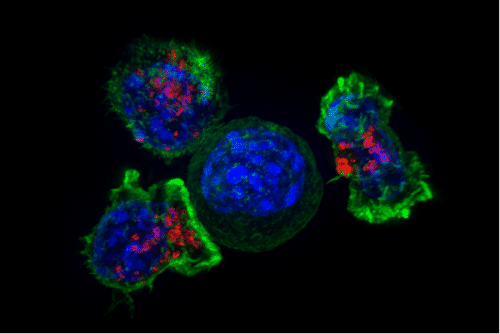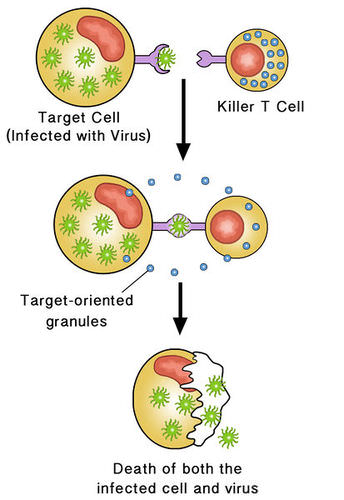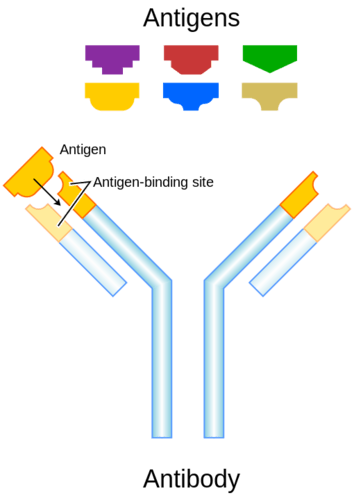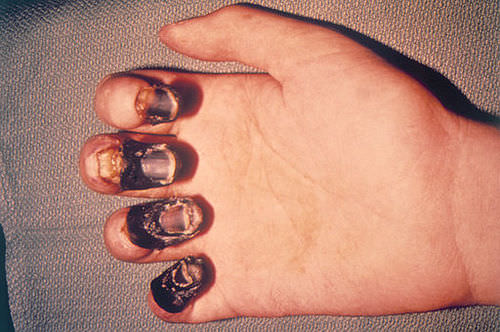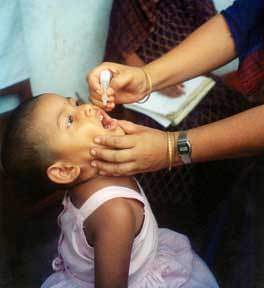19.5 适应性免疫免疫系统
章节大纲
-
The Kiss of Death
::死亡之吻This photomicrograph shows a group of killer T cells (green and red) surrounding a (blue, center). When a killer T cell makes contact with the cancer cell, it attaches to and spreads over the dangerous target. The killer T cell then uses special chemicals stored in vesicles (red) to deliver the killing blow. This event has thus been nicknamed “the kiss of death.” After the target cell is killed, the killer T cells move on to find the next victim. Killer T cells like these are important players in the adaptive immune system .
::照片摄影显示一组杀手T细胞(绿色和红色)围绕一个(蓝色,中心)周围。当杀手T细胞与癌症细胞接触时,它附着在危险目标上并扩散到危险目标上。杀手T细胞然后使用储存在(红色)乳胶中的特殊化学物质来进行杀戮打击。因此,这一事件被命名为“死亡之吻 ” 。 在目标细胞死亡后,杀手T细胞继续寻找下一个受害者。这样的杀手T细胞在适应性免疫系统中是重要的角色。What Is the Adaptive Immune System?
::什么是适应性免疫系统?The adaptive immune system is a subsystem of the overall immune system. It is composed of highly specialized cells and processes that eliminate specific and tumor cells. An adaptive immune response is set in motion by antigens that the immune system recognizes as foreign. Unlike an innate immune response, an adaptive immune response is highly specific to a particular pathogen (or its antigen). An important function of the adaptive immune system that is not shared by the is the creation of immunological memory — or — which occurs after the initial response to a specific pathogen. It allows for a faster, stronger response on subsequent encounters with the same pathogen, usually before the pathogen can even cause symptoms of illness.
::适应性免疫系统是整个免疫系统的子系统,由高度专业化的细胞和过程组成,消除特定细胞和肿瘤细胞;由免疫系统承认为外来的抗原启动适应性免疫反应;与先天免疫反应不同的是,适应性免疫反应对特定病原体(或其抗原)非常特殊;适应性免疫系统的一个重要功能是创造免疫记忆,或是在对特定病原体最初作出反应之后发生的,它允许对随后遇到的同一病原体作出更快、更有力的反应,通常在病原体甚至能够造成疾病症状之前。Lymphocytes are the main cells of the adaptive immune system. They are leukocytes that arise and mature in organs of the , including the bone marrow and thymus . The normally has about two trillion lymphocytes, which constitute about one-third of all leukocytes. Most of the lymphocytes are normally sequestered within tissue fluid or organs of the lymphatic system, including the tonsils, spleen , and lymph nodes . Only about two percent of the lymphocytes are normally circulating in the . There are two main types of lymphocytes involved in adaptive immune responses, called T cells and B cells . T cells destroy infected cells or release chemicals that regulate immune responses. B cells secrete antibodies that bind with antigens of pathogens so they can be removed by other immune cells or processes.
::淋巴细胞是适应性免疫系统的主要细胞。它们是在包括骨髓和胸腺在内的人体器官中产生和成熟的白血球。通常有大约2万亿淋巴细胞,约占所有白血球的三分之一。大部分淋巴细胞通常在淋巴系统的组织液或器官中被固化,包括、脾和淋巴结。只有大约2%的淋巴细胞通常在淋巴细胞中流通。在适应性免疫反应中,有两种主要类型的淋巴细胞,称为T细胞和B细胞。细胞摧毁受感染的细胞或释放控制免疫反应的化学物质。细胞秘密抗体与病原抗体结合,以便被其他免疫细胞或过程清除。T Cells
::T 单元格There are multiple types of T cells, or T lymphocytes. Major types are killer (or cytotoxic) T cells and helper T cells . Both types develop from immature T cells that become activated by exposure to an antigen.
::有多种T型细胞,即T型淋巴细胞。主要类型是杀手(或细胞毒性)T型细胞和帮助T型细胞。两种类型都来自不成熟的T型细胞,它们通过接触抗原而产生作用。T Cell Activation
::T 细胞激活T cells must be activated to become either killer T cells or helper T cells. This requires presentation of a foreign antigen by antigen-presenting cells, as shown in the figure . Antigen-presenting cells may be dendritic cells, macrophages, or B cells. Activation occurs when T cells are presented with a foreign antigen coupled with an MHC self antigen. Helper T cells are more easily activated than killer T cells. Activation of killer T cells is strongly regulated and may require additional stimulation from helper T cells.
::T细胞必须被激活,才能成为杀手T细胞或帮手T细胞。这要求如图所示,用抗原显示的细胞展示外来抗原。抗原显示的细胞可以是登地细胞、巨形细胞或B细胞。T细胞与外国抗原同时配有MHC自抗原时,就会激活。T帮助T细胞比T杀手更容易激活。T杀手细胞的激活受到严格管制,可能需要帮助T细胞的更多刺激。Exposure to a foreign antigen on an antigen-presenting cell is necessary to activate T cells to become killer T cells or helper T cells.
::要激活T细胞成为杀手T细胞或帮手T细胞,就必须在显示抗原的细胞上接触外国抗原。Killer T Cells
::杀手T细胞Activated killer T cells induce the death of cells that bear a specific non-self antigen because they are infected with pathogens or are cancerous. The antigen targets the cell for destruction by killer T cells, which travel through the bloodstream searching for target cells to kill. Killer T cells may use various mechanisms to kill target cells. One way is by releasing toxins in granules that enter and kill infected or cancerous cells (see figure ).
::活性杀手T细胞诱发细胞死亡,这些细胞由于感染病原体或癌症而带有特定的非自我抗原。抗原针对的细胞被致命T细胞摧毁,这些细胞通过血流寻找目标细胞来杀人。杀手T细胞可能使用各种机制来杀死目标细胞。一种方法是释放进入并杀死受感染或癌症细胞的颗粒中的毒素(见图 )。A killer T cell releases toxins that destroy an infected body cell and the viruses it contains.
::致命T型细胞释放毒素 摧毁被感染的身体细胞和病毒Helper T Cells
::帮助 T 单元格Activated helper T cells do not kill infected or cancerous cells. Instead, their role is to “manage” both innate and adaptive immune responses by directing other cells to perform these tasks. They control other cells by releasing cytokines , which are that can influence the activity of many cell types, including killer T cells, B cells, and macrophages. S ome cytokines released by helper T cells assist with the activation of killer T cells.
::激活的帮助细胞T不会杀死受感染或癌症的细胞,相反,它们的作用是通过引导其他细胞执行这些任务来“管理”天生和适应性免疫反应。 它们通过释放细胞外皮来控制其他细胞,这些细胞会影响许多细胞类型的活动,包括致命的T细胞、B细胞和大型细胞。 由帮助细胞T释放的一些细胞有助于激活致命T细胞。B Cells
::B 单元格单元格B cells , or B lymphocytes, are the major cells involved in the creation of antibodies that circulate in blood plasma and lymph . Antibodies are large, Y-shaped proteins used by the immune system to identify and neutralize foreign invaders. Besides producing antibodies, B cells may also function as antigen-presenting cells, or secrete cytokines that help control other immune cells and responses.
::B细胞,即B淋巴细胞,是产生在血浆和淋巴中循环的抗体的主要细胞。 抗体很大,是免疫系统用来识别和中和外来入侵者的Y型蛋白质。 除了产生抗体外,B细胞也可以发挥抗原呈现细胞的作用,或有助于控制其他免疫细胞和反应的秘密细胞。B Cell Activation
::B 细胞激活Before B cells can actively function to defend the host , they must be activated. As shown in the figure , B cell activation begins when a B cell engulfs and digests an antigen. The antigen may be either free floating in the lymph, or it may be presented by an antigen-presenting cell, such as a dendritic cell or macrophage. In either case, the B cell then displays antigen fragments bound to its own MHC antigens. The MHC-antigen complex on the B cell attracts helper T cells. The helper T cells, in turn, secrete cytokines that help the B cell to multiply, and the daughter cells to mature into plasma cells .
::如图所示,B细胞的活化始于B细胞吞没和消化抗原时。抗原可能是在淋巴中自由漂浮的,也可能是由显示抗原的细胞,如嵌入式细胞或大型细胞呈现出来。在两种情况下,B细胞随后显示与其本身的MHC抗原结合的抗原碎片。B细胞的MHC抗原综合体吸引了帮助者T细胞。帮助者T细胞反过来是有助于B细胞增殖的秘密细胞,而母细胞则成熟成血浆细胞。B cells are activated and become antibody-producing plasma cells with the help of helper T cells.
::B细胞被激活,在帮助T细胞的T细胞的帮助下成为产生抗体的等离子细胞。Plasma Cells
::Plasma 单元格Plasma cells are antibody-secreting cells that form from activated B cells. Each plasma cell is like a tiny antibody factory. It may secrete millions of copies of an antibody, each of which can bind to the specific antigen that activated the original B cell. The specificity of an antibody to a specific antigen is illustrated in the figure . When antibodies bind with antigens, it makes the cells bearing them easier targets for phagocytes to find and destroy. Antibody-antigen complexes may also trigger the complement system of the innate immune system, which destroys the cells in a cascade of protein . In addition, the complexes are likely to clump together (agglutinate). If this occurs, they are filtered out of the blood in the spleen or liver .
::等离子体细胞是活性B细胞形成的抗体保密细胞。 每个等离子细胞就像一个微小的抗体工厂。 它可能隐藏数百万份抗体, 每种抗体都可以与激活原B细胞的特定抗原结合。 图中显示了抗体与特定抗原的特性。 当抗体与抗原结合时, 它会让带有这些抗体的细胞更容易被截取和摧毁。 抗体抗原复合体还可能触发内生免疫系统的补充系统, 后者将细胞摧毁在蛋白质级联中。 此外, 复合体可能会被凝聚在一起( gglutinate) 。 如果发生这种情况, 它们会从胸或肝脏的血液中过滤出来。Each antibody fits its antigen like a lock fits a key.
::每个抗体都适合它的抗原 就像锁一样适合钥匙Immunity
::豁免豁免豁免Once a pathogen has been cleared from the body, m ost activated T cells and B cells die within a few days. A few of the cells, however, survive and remain in the body as memory T cells or memory B cells. These memory cells are ready to activate an immediate response if they are exposed to the same antigen again in the future. This is the basis of immunity.
::一旦从身体中清除了病原体,大多数活性T细胞和B细胞在几天内死亡。但是,有几个细胞存活下来,并留在身体中作为记忆T细胞或记忆B细胞。这些记忆细胞准备在将来再次接触同一种抗原时立即作出反应。这是免疫的基础。The earliest known reference to the concept of immunity relates to the bubonic plaque (see photo ). In 430 B.C., a Greek historian and general named Thucydides noted that people who had recovered from a previous bout of the plague could nurse people who were sick with the plague without contracting the illness a second time. We now know that this is true of many diseases, and that it occurs because of active immunity .
::在公元前430年,希腊历史学家兼将军Thucydides指出,从前一次瘟疫中恢复过来的人可以照顾患有瘟疫的人,而不必第二次感染这种疾病。 我们现在知道,许多疾病都是如此,之所以发生,是因为积极免疫。Dead, blackened tissues at the finger tips and other extremities are a sign of the bubonic plague, giving rise to its other name, the black death.
::死亡,黑化的组织 手指尖和其他极端 是鼠疫的征兆, 引起它的另一个名字, 黑人死亡。Active Immunity
::现行豁免Active immunity is the ability of the adaptive immune system to resist a specific pathogen because it has formed an immunological memory of the pathogen. Active immunity is adaptive, because it occurs during the lifetime of an individual as an adaptation to infection with a specific pathogen, and prepares the immune system for future challenges from that pathogen. Active immunity can come about naturally or artificially.
::活性免疫是适应性免疫系统抵抗特定病原体的能力,因为它已经形成了病原体的免疫记忆。 活性免疫是适应性的,因为它发生在一个人的一生中,是适应特定病原体感染的适应性,并且为免疫系统应对该病原体今后的挑战做好准备。 活性免疫可以自然地或人为地产生。Naturally Acquired Active Immunity
::自然获得的主动豁免Active immunity is acquired naturally when a pathogen invades the body and activates the adaptive immune system. When the initial infection is over, memory B cells and memory T cells remain, providing immunological memory of the pathogen. As long as the memory cells are alive, the immune system is ready to mount an immediate response if the same pathogen tries to infect the body again.
::当病原体侵入人体并激活适应性免疫系统时,自然获得活性免疫。当初始感染结束时,记忆B细胞和记忆T细胞将留下,为病原体提供免疫记忆。只要记忆细胞还活着,如果同一病原体试图再次感染人体,免疫系统将立即作出反应。Artifically Acquired Active Immunity
::人为获得主动豁免Active immunity can also be acquired artificially through immunization . Immunization is the deliberate exposure of a person to a pathogen in order to provoke an adaptive immune response and the formation of memory cells specific to that pathogen. The pathogen is introduced in a vaccine — usually by injection, sometimes by nose or mouth (see the photo ) — so immunization is also called vaccination .
::免疫是指一个人故意接触病原体,以引起适应性免疫反应和形成该病原体特有的记忆细胞,这种病原体通常通过注射、有时通过鼻子或嘴部注射(见照片)引入疫苗,因此免疫也称为疫苗接种。This young child is receiving an oral polio vaccine.
::这名幼儿正在接受口服脊髓灰质炎疫苗。Typically, only part of a pathogen, a weakened form of the pathogen, or a dead pathogen is used in a vaccine , which causes an adaptive immune response without making the immunized person sick. This is how you most likely became immune to diseases such as measles, mumps, and chicken pox. Immunizations may last for a lifetime, or they may require periodic booster shots to maintain immunity. While immunization generally has long-lasting effects, it usually takes several weeks to develop full immunity.
::通常,疫苗只使用病原体的一部分,病原体的衰弱形式,或死亡病原体,在不使接受免疫的人生病的情况下造成适应性免疫反应。这就是你最有可能对麻疹、流行性腮腺炎和天花等疾病免疫的方式。 免疫可能持续一生,或者可能需要定期的助推针来保持免疫。 虽然免疫通常具有长期影响,但通常需要几个星期才能获得完全免疫。Immunization is the most effective method ever discovered of preventing . As many as three million deaths are prevented each year because of vaccinations. Widespread immunity from vaccinations is largely responsible for the worldwide eradication of smallpox, and the near elimination of several other infectious diseases from many , including polio and measles. Immunization is so successful because it exploits the natural specificity and inducibility of the adaptive immune system.
::免疫是有史以来最有效的预防方法。每年有多达300万人因接种疫苗而预防死亡。广泛免疫是全世界消灭天花和几乎消除包括小儿麻痹症和麻疹在内的其他几种传染病的主要原因。免疫如此成功,因为它利用了适应性免疫系统的自然特性和教育。Passive Immunity
::被动豁免Passive immunity results when pathogen-specific antibodies or activated T cells are transferred to a person who has never been exposed to the pathogen. Passive immunity provides immediate protection from a pathogen, but the adaptive immune system does not develop immunological memory to protect the host from the same pathogen in the future. Unlike active immunity, passive immunity lasts only as long as the transferred antibodies or T cells survive in the blood — usually between a few days and a few months. However, like active immunity, passive immunity can be acquired both naturally and artificially.
::当病原体抗体或活性T细胞被转移到从未接触过病原体的人身上时,将产生被动的免疫豁免结果;被动的豁免可提供直接保护,使其免受病原体的危害,但适应性免疫系统不会发展免疫记忆,以保护宿主今后免受同一种病原体的感染;与主动豁免不同,被动的豁免只能持续到转移的抗体或T细胞在血液中存活下来(通常为几天至几个月),但是,像主动豁免一样,被动的豁免可以自然和人工获得。Naturally Acquired Passive Immunity
::自然获得的被动豁免Passive immunity is acquired naturally by a fetus through its mother’s blood. Antibodies are transported from mother to fetus across the placenta , so babies have high levels of antibodies at birth. Their antibodies have the same range of antigen specificities as their mother’s. Passive immunity may also be acquired by an infant through the mother’s breast milk. This gives young infants protection from common pathogens in their environment while their own immune system matures.
::胎儿通过母亲的血液自然获得被动免疫。 抗体在整个胎盘中从母亲转移到胎儿,因此婴儿出生时的抗体水平很高。 他们的抗体具有与母亲相同的抗原特性。 婴儿也可以通过母亲的母乳获得被动免疫。 这使婴儿在自己的免疫系统成熟时免受环境中常见病原体的侵扰。Artificially Acquired Passive Immunity
::人为获得被动豁免Older children and adults can acquire passive immunity artificially through the injection of antibodies or activated T cells, which may be done when there is a high risk of infection and insufficient time for the body to develop active immunity through vaccination. It may also be done to reduce symptoms of ongoing disease, or to compensate for diseases.
::年龄较大的儿童和成人可以通过人工注射抗体或活性T细胞获得被动免疫,这种注射可以在感染风险高和身体没有足够的时间通过接种疫苗发展积极免疫的情况下进行,也可以减少持续疾病的症状,或对疾病进行补偿。Adaptive Immune Evasion
::适应性免疫弹射Many pathogens have been around for a long time, living with human populations for generations. To persist, some have evolved mechanisms to evade the adaptive immune system of human hosts. One way they have done this is by rapidly changing their non-essential antigens. This is called antigenic variation. An example of a pathogen that takes this approach is human immunodeficiency virus (HIV). It mutates rapidly so the proteins on its viral envelope are constantly changing. By the time the adaptive immune system responds, the virus’s antigens have changed. Antigenic variation is the main reason that efforts to develop a vaccine against have not yet been successful.
::许多病原体已经存在了很长一段时间,与人类共同生活了几代人。一些病原体已经发展出逃避人类宿主的适应性免疫系统的机制。它们这样做的一种方法是迅速改变其非基本抗原。这被称为抗原变异。采用这一方法的病原体的一个例子是人体免疫机能丧失病毒(HIV ) 。它迅速变异,其病毒包内的蛋白不断变异。在适应性免疫系统作出反应时,病毒的抗原已经改变。抗原变异是研制疫苗的努力尚未成功的主要原因。Another evasion approach that some pathogens may take is to mask pathogen antigens with host molecules so the host’s immune system cannot detect the antigens. HIV takes this approach, as well. The envelope that covers the is formed from the outermost membrane of the host cell.
::某些病原体可能采取的另一个规避办法是用宿主分子掩盖病原体抗原,这样宿主的免疫系统就无法检测抗原。 艾滋病毒也采取了这一方法。 覆盖病毒的包包由宿主细胞最外层膜形成。Feature: My Human Body
::特质:我的人体If you think that immunizations are just for kids, think again. There are several vaccines recommended by the CDC for people over the age of 18. The table at the Web site below shows the vaccine schedule recommended for all adults 19 years and older. Additional vaccines may be recommended for certain adults based on specific medical conditions or other indications. Are you up to date with your vaccines? You can check with your doctor to be sure.
::如果您认为免疫只是针对孩子的,请再考虑一下。疾病防治中心建议为18岁以上的人提供几种疫苗。下面的网站的表格显示了为所有19岁及以上成年人建议的疫苗时间表。根据特定医疗条件或其他迹象,可以建议为某些成年人提供其他疫苗。您是否更新了疫苗?您可以向医生确认一下。Summary
::摘要-
The adaptive immune system is a subsystem of the overall immune system that recognizes and makes a tailored attack against specific pathogens or tumor cells. It is a slower, but more effective response than the innate immune response, and also leads to immunity to particular pathogens.
::适应性免疫系统是整个免疫系统的一个子系统,它承认并针对特定病原体或肿瘤细胞进行了量身定做的攻击,比天生的免疫反应慢,但更有效的反应,也导致特定病原体的豁免。 -
Lymphocytes produced by the lymphatic system are the main cells of the adaptive immune system. There are two major types of lymphocytes: T cells and B cells. Both types must be activated by foreign antigens to become functioning immune cells.
::淋巴细胞系统产生的淋巴细胞是适应性免疫系统的主要细胞,有两大类淋巴细胞:T细胞和B细胞,两种类型都必须由外国抗原激活,才能成为功能性免疫细胞。 -
Most activated T cells become either killer T cells or helper T cells. Killer T cells destroy cells that are infected with pathogens or are cancerous. Helper T cells manage immune responses by releasing cytokines that control other types of leukocytes.
::大部分活性T细胞要么成为杀手T细胞,要么成为帮手T细胞。杀手T细胞摧毁感染病原体或癌症的细胞。帮助T细胞通过释放控制其他类型白血球的细胞来控制免疫反应。 -
Activated B cells form plasma cells that secrete antibodies, which bind to specific antigens on pathogens or infected cells. The antibody-antigen complexes generally lead to the destruction of the cells, for example, by attracting phagocytes or triggering the complement system.
::活性B细胞形成分离抗体的等离子细胞,与病原体或受感染细胞上的特定抗原结合,抗体抗原综合体通常导致细胞的破坏,例如通过吸引发细胞或触发补充系统。 -
After an adaptive immune response occurs, long-lasting memory B cells and memory T cells may remain to confer immunity to the specific pathogen that caused the adaptive immune response. These memory cells are ready to activate an immediate response if they are exposed to the same antigen again in the future.
::在适应性免疫反应发生后,长效记忆B细胞和记忆T细胞可能保留,以便给导致适应性免疫反应的特定病原体以免疫。 这些记忆细胞准备在将来再次接触同一种抗原时立即启动反应。 -
Immunity may be active or passive. Active immunity occurs when the immune system has been presented with antigens that elicit an adaptive immune response. This may occur naturally as the result of an infection, or artificially as the result of immunization. Active immunity may last for years or even for life.
::当向免疫系统提供抗原,引起适应性免疫反应时,即为主动豁免,这可以自然地因感染而发生,或者人为地因免疫而发生。 主动豁免可以持续数年甚至终生。 -
Passive immunity occurs without an adaptive immune response by the transfer of antibodies or activated T cells. This may occur naturally between a mother and her fetus or her nursing infant, or it may occur artificially by injection. Passive immunity lasts only as long as the antibodies or activated T cells remain alive in the body, generally just weeks or months.
::被动免疫性豁免发生时,没有通过转移抗体或活性T细胞来作出适应性免疫反应,这可能自然发生在母亲与胎儿或哺乳婴儿之间,也可能是人工注射。 被动免疫性豁免只有在抗体或活性T细胞在身体中存活,通常只有几周或几个月。 -
Many pathogens have evolved mechanisms to evade the adaptive immune system. For example, human immunodeficiency virus (HIV) evades the adaptive immune system by frequently changing its antigens and by forming its outer envelope from the host’s cell membrane.
::许多病原体已经发展出逃避适应性免疫系统的机制。 比如,人体免疫机能丧失病毒(HIV)通过频繁改变抗原和从宿主细胞膜中形成外壳来规避适应性免疫系统。
Review
::回顾1. What is the adaptive immune system?
::1. 什么是适应性免疫系统?2. Describe the main cells of the adaptive immune system.
::2. 描述适应性免疫系统的主要细胞。3. How are lymphocytes activated?
::3. 淋巴细胞是如何激活的?4. Identify two common types of T cells and their functions.
::4. 确定两个共同的T类单元及其功能。5. How do activated B cells help defend against pathogens?
::5. 活性B细胞如何帮助防范病原体?6. Define immunity.
::6. 界定豁免。7. What are two ways that active immunity may come about?
::7. 主动豁免可以产生哪些两种方式?8. How does passive immunity differ from active immunity?
::8. 被动豁免与主动豁免有何不同?9. How may passive immunity occur?
::9. 被动豁免如何发生?10. What ways of evading the human adaptive immune system evolved in human immunodeficiency virus (HIV)?
::10. 在人体免疫机能丧失病毒(艾滋病毒)方面,如何避免人类适应性免疫机能丧失系统的发展?11. Describe two ways in which B cells and T cells work together to generate adaptive immune responses.
::11. 描述B细胞和T细胞为产生适应性免疫反应而合作的两种方式。12. Which cells directly kill pathogen-infected or cancerous cells?
::12. 哪些细胞直接杀死受病原体感染的细胞或癌症细胞?a. plasma cells
::a.等离子电池b. killer T cells
::b. 杀手T细胞c. helper T cells
::c. 帮助T单元格d. all of the above
::d. 以上所有情况13. Why do vaccinations expose a person to a version of a pathogen?
::13. 为什么接种疫苗会使一个人接触一种病原体?14. True or False: Immunization is a form of passive immunity.
::14. 真实或假:免疫是一种被动豁免形式。15. True or False: Antibodies transmitted from mother to child via breast milk cause the formation of memory B cells and long-term immunity.
::15. 真实或假体:通过母乳从母亲传给婴儿的抗体,形成记忆B细胞和长期免疫。Explore More
::探索更多Watch this video to learn about the status of HIV vaccine development:
::观看这段影片, 了解艾滋病毒疫苗研发情况:Ever wonder why you need to get a flu vaccine every year? Learn more here:
::想知道为什么你每年需要接种流感疫苗吗? -
The adaptive immune system is a subsystem of the overall immune system that recognizes and makes a tailored attack against specific pathogens or tumor cells. It is a slower, but more effective response than the innate immune response, and also leads to immunity to particular pathogens.
